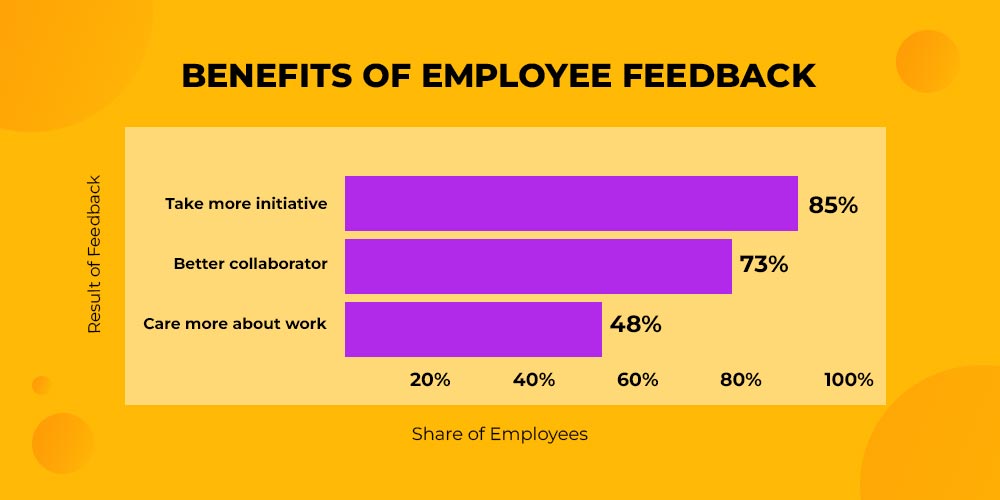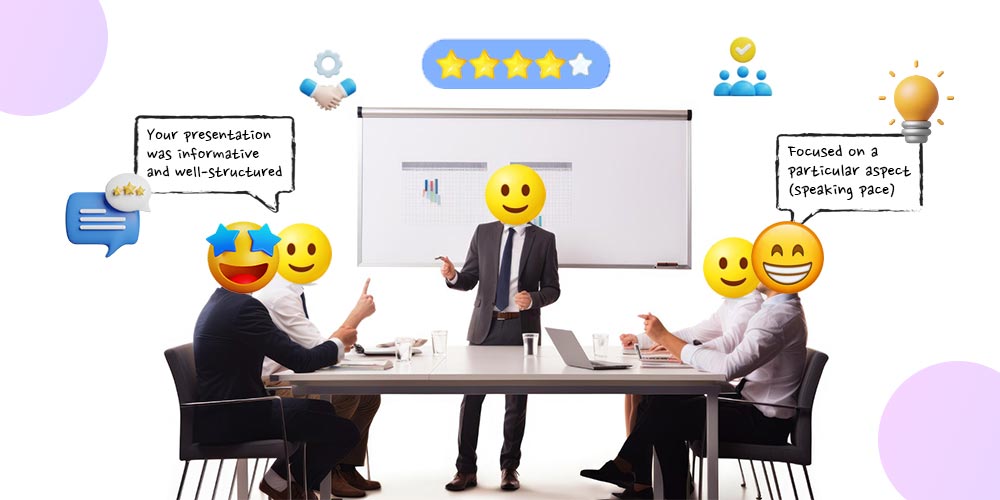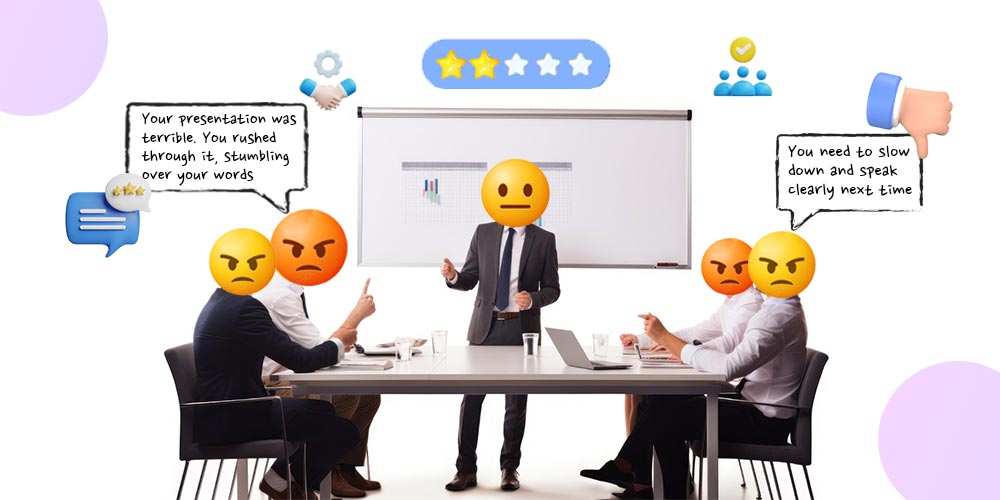Giving Feedback Made Easy: Expert Tips for Better Conversations
“Feedback is the breakfast of champions.” – Ken Blanchard
Picture this: You’re cruising down the feedback highway, windows down, wind in your hair, and a roadmap of ambitions sprawled out before you. But wait, what’s that up ahead? Roadblocks of criticism, detours of defensiveness, and the occasional speed bump of emotions threaten to derail your journey. Fear not, fellow traveler, for armed with the right tools and mindset, you’re about to turn those obstacles into stepping stones toward success.
In the fast-paced world of the workplace, feedback isn’t just a pit stop; it’s the fuel that propels us toward personal and professional greatness. So buckle up and join us as we navigate the twists and turns of giving and receiving feedback, discovering how to transform moments of frustration into opportunities for growth and triumph.
Welcome aboard the feedback express – next stop, success! 🚀
Why is Feedback Important in the Workplace?
Think of feedback as the compass guiding your ship through the stormy waters of personal and professional development. It’s the fuel that propels us forward, helping us course-correct, improve, and ultimately reach our destination. Without it, we risk sailing blindly, unaware of the rocks lurking beneath the surface.


Giving and receiving feedback are essential components of a healthy and productive workplace environment for several reasons:
- Improvement and Growth: Feedback provides individuals with valuable insights into their performance, helping them identify strengths to build upon and areas for improvement. By receiving feedback, employees can refine their skills and enhance their effectiveness in their roles, contributing to personal and professional growth.
- Enhanced Communication: Feedback fosters open and transparent communication within teams and across organizational hierarchies. It encourages dialogue, collaboration, and the exchange of ideas, leading to better understanding and alignment of goals and expectations.
- Increased Accountability: Regular feedback sessions create accountability among team members, as they are encouraged to take ownership of their actions and outcomes. Constructive feedback helps individuals understand how their contributions impact team and organizational goals, promoting a sense of responsibility and commitment.
- Building Trust and Relationships: Constructive feedback, when delivered with empathy and respect, strengthens trust between colleagues and supervisors. It demonstrates a genuine interest in supporting each other’s growth and success, fostering positive relationships based on mutual respect and understanding.
- Course Correction and Adaptation: In a dynamic and rapidly changing work environment, feedback serves as a compass for course correction and adaptation. It helps individuals and teams identify challenges, address issues proactively, and adjust strategies to achieve desired outcomes more effectively.
- Recognition and Motivation: Positive feedback not only highlights areas for improvement but also acknowledges and celebrates achievements and successes. Recognizing individuals’ contributions and efforts boosts morale, motivation, and job satisfaction, fostering a culture of appreciation and recognition.
- Continuous Learning Culture: Embracing feedback creates a culture of continuous learning and development within the organization. It encourages individuals to seek feedback regularly, be receptive to diverse perspectives, and continuously strive for excellence in their work.


Constructive Criticism Vs Destructive Criticism
Let’s break down the crucial differences between constructive and destructive criticism with a couple of examples:
Constructive Criticism:
Imagine you’ve just completed a presentation at work, and your colleague approaches you with feedback. They say, “Your presentation was informative and well-structured. However, I noticed that you spoke quite quickly, which made it a bit hard to follow at times. Perhaps practicing a slower pace could enhance clarity and engagement for the audience.”


Here, the feedback is specific, focused on a particular aspect (speaking pace), and offers a suggestion for improvement (practice speaking slower). It acknowledges strengths while highlighting areas for growth in a supportive manner.
Destructive Criticism:
Now, let’s consider a different scenario. After the same presentation, another colleague approaches you and says, “Your presentation was terrible. You rushed through it, stumbling over your words. You need to slow down and speak clearly next time.”


In this instance, the feedback lacks specificity and is overly negative. It focuses solely on the flaws without acknowledging any positive aspects of the presentation. Instead of offering constructive suggestions, it simply criticizes without guiding how to improve.
Steps to Receiving and Giving Feedback:
Receiving Feedback:
- Approach with an open mind: Leave defensiveness at the door and embrace feedback as an opportunity for growth.
- Listen actively: Pay attention to what is being said without interrupting or formulating your response prematurely.
- Seek clarification: If something is unclear, don’t hesitate to ask questions for better understanding.
- Reflect and act: Take time to digest the feedback, reflect on its validity, and devise a plan for improvement.
Giving Feedback:
- Choose the right time and place: Ensure the feedback is given in a private setting and at a time when both parties are receptive.
- Be specific and objective: Provide concrete examples and focus on behaviors rather than personal attributes.
- Offer solutions: Instead of dwelling solely on the problem, collaborate on finding solutions and setting goals for improvement.
- Follow up: Check in periodically to monitor progress and offer ongoing support and encouragement.
Handling Difficult Situations:
Sometimes, receiving feedback can be challenging, especially when emotions run high. Here’s how to navigate tricky situations:
- Stay calm and composed: Take deep breaths and maintain a calm demeanor to defuse tension.
- Acknowledge emotions: Validate the other person’s feelings and demonstrate empathy.
- Redirect the focus: Reframe the conversation from blame to problem-solving, focusing on finding solutions together.
- Offer support: Let the person know you’re there to help and support them in their growth journey.
Giving Feedback to People Who Cry, Yell, or Get Defensive:
- Approach with empathy: Recognize that emotions are a natural response to feedback and respond with empathy and understanding.
- Stay focused: Acknowledge the emotions but gently steer the conversation back to the feedback and solutions.
- Provide a safe space: Assure the individual that their feelings are valid and that the feedback is intended to support their growth.
- Offer a break if needed: If emotions become overwhelming, suggest taking a break and reconvening when both parties are calmer.
In wrapping up, remember that behind every piece of feedback, there’s a human being—someone with hopes, fears, and dreams, just like you and me. So, let’s approach these conversations with empathy, understanding, and a sprinkle of kindness. Together, we can turn feedback from something daunting into a tool for growth and connection.
May your feedback journeys be filled with understanding, growth, and a sprinkle of kindness!







